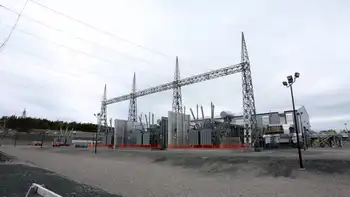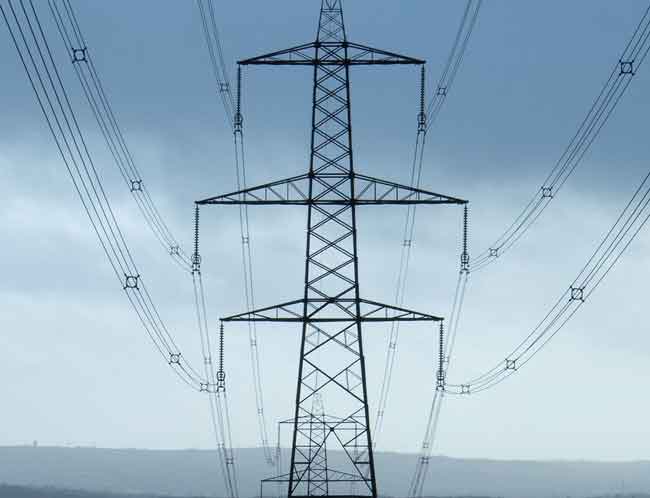Funding questions linger as power plant breaks ground
By Great Falls Tribune
High Voltage Maintenance Training Online
Our customized live online or in‑person group training can be delivered to your staff at your location.

- Live Online
- 12 hours Instructor-led
- Group Training Available
Highwood developers continue to express optimism that the project will obtain financing.
The rural electric cooperatives developing the plant would not be "wasting money doing what we're doing right now" if financing was not available, said Tim Gregori, general manager of the Billings-based Southern Montana Electric Generation & Transmission Cooperative, the developer of the plant.
A Colorado-based analyst familiar with the energy industry and a University of Montana research professor said that the project still faces financial hurdles.
A worldwide financial crisis adds another layer of complexity to the project, although it does not appear to be the most crucial one, according to Steve Piper, managing director of forecasting for Platts, a leading global provider of energy and metals information, and a division of McGraw Hill Companies.
"The current credit crunch certainly makes it tougher," Piper said.
Financing is available for "a good, sound project," even in today's uncertain credit climate, Gregori said. SME broke ground on the project, and work is under way to prepare the site for foundations.
The initial phase of work is being paid for with "financing from a variety of banks," Gregori said. "We'll put our financing package together in phases, and this is the first phase of our financial package."
Highwood Generating Station is being developed by the four Montana rural electric cooperatives that belong to SME. A fifth co-op, Yellowstone Valley Electric, along with the city of Great Falls, is an SME member that initially contributed development money to the project. Neither Great Falls nor YVE has joined a new entity that will develop the plant in its later stages.
Even big fish in the energy industry face challenges amid the current global economic chaos. Last week, the head of Missouri's largest utility, AmerenUE, cited credit difficulties in seeking a hefty rate hike from state regulators there.
"AmerenUE is currently unable to issue commercial paper, and has experienced difficulty in accessing credit from other sources," said Thomas R. Voss in testimony filed with the Missouri Public Service Commission. Commercial paper is an unsecured obligation usually issued by a highly rated corporation for short-term cash needs.
Thomas Power, a University of Montana research professor in economics, said many energy companies "are actually in quite good financial shape" these days compared with a year or two ago, despite the world's financial mess.
However, Power said big utilities are becoming more cautious in the current financial climate.
He added that the larger utilities continue to build coal-fired power plants here and there, although such plants often are opposed by environmental groups, such as the Sierra Club. Environmentalists concerned about air pollution and climate change often put up strong opposition, as they have in Great Falls.
"It just seems clear that coal is not a great investment," said Dan Ritzman, the Seattle-based director of the Sierra Club's Western Coal Campaign.
A National Energy Technology report in June said 29 coal-fired power plants were under construction nationwide, five were nearing construction and 18 additional plants received permits, including the proposed Highwood Generating Station. The declines in North American natural gas production "highlight the importance of coal-fired power generation to the nation's energy security and economy," the report added.
Montana has seen a slight increase in demand for its coal recently, and coal prices are on the rise, said Bud Clinch, executive director of the Montana Coal Council. However, Clinch said coal has an image problem because of concerns over climate change.
Coal-mining firms hope cleaner technology will give the industry a boost.
"My membership is fairly optimistic that technology is going to continue to emerge," Clinch said. "Coal is a huge part of our energy supply."
Piper said financing has posed challenges for the Highwood power plant project, which, along with several other coal-fired power plant projects nationwide, was rebuffed for low-interest loans by the federal Rural Utilities Service earlier this year. The agency slapped a moratorium on such loans for fiscal year 2008, and perhaps FY2009.
Piper said one key for the Highwood project in securing financing is to make sure at least 85 percent of the electricity it produces is spoken.
"The facility still has a lot of speculative exposure," Piper said. "I don't think that the financial community will move until (85 percent is sold)."
Various figures have been bandied about on how much of the plant's potential power is spoken for. In a letter to Gregori on Feb. 19, James M. Andrew, administrator for the RUS Utilities Program, stated that 60 percent of the plant's output was under contract.
Gregori disagreed.
"That figure was far too low," Gregori said. "We have an adequate percentage of the plant subscribed to meet the requirements of our lending."
He declined to release that number.
A record of decision document said the co-ops' 2008 requirements for power were about 160 megawatts, or 64 percent of the plant's 250 megawatt capacity. In addition, the city of Great Falls needs about 25 megawatts for its customers. That places the plant's contracted power at about 74 percent of capacity.
Many projects in more populous areas line up buyers prior to construction for virtually all the power a new plant would produce. Piper noted that in the case of a Southern Illinois Prairie State energy project developers contracted a high percentage of its electricity "in order to make that project go through."
The city of Great Falls tried to interest other Montana city governments in buying power from Highwood Generating Station, but to no avail. A central Washington public utility district, the Grant County PUD, also dropped out as a potential buyer. PUD board members said they opted out because they did not have enough time to study the issue.
The 2007 Montana Legislature also refused to allow Great Falls to become an electric supplier for city residents because such a move could hurt the state's dominant electric utility, NorthWestern Energy.
Piper said electricity produced in Montana used to typically find its way west, where states such as California and Washington now turn up their noses at electricity produced by coal-fired plants.
"I think that it would be difficult," Piper said. "I don't know where they're going to find the buyers."
Power said that there is some wiggle room in terms of the electricity contracted out as power-plant developers can cite peak load figures, or times when the most electricity is required, to make things look a little better.
Gregori said he believes developers have enough customers to make the plant feasible.
Piper said he believes the power plant could be funded if it secures additional commitments for its electricity.
"I think they would have a shot at it," he said. "The energy sector is still getting a lot of interest. Core investments in energy are still pretty strong.
"I think they're going to keep trying," Piper added. However, he noted that breaking ground may not be a definitive act.
"It's not necessarily unusual to do that type of preparatory activity," Piper said.
Various sources of financing have been mentioned over the years for the Montana project.
In late spring, Gregori said project officials looked at obtaining investment-grade ratings from two Wall Street firms as early as August to enable power plant to be financed using bonds. In August, Gregori said the project had not applied for the ratings.
Gregori and other co-op officials recently have discussed obtaining financing from commercial lenders.
Piper said obtaining a bank loan is probably low on the list of options SME would consider.
Gregori said the changes in prospective financing are not significant.
Coleen Balzarini, the city's fiscal officer, said that it is possible that a mix of bank loans and bonds could be used to finance the Highwood Generating Station.
In the meantime, SME has lined up short-term financing. Gregori said the project has obtained a significant piece of financing from commercial banks, but declined to identify the amount or the lenders.
John Prinkki, head of the Beartooth Electric Cooperative in Red Lodge, which is a member of SME, previously said the project sought a $10 million to $15 million loan.
Power said rural electric cooperatives have advantages over other energy developers because they are not regulated by the Montana Public Service Commission, which allows them to more easily proceed with projects.
"A utility is in a somewhat different situation if they have customers who they can bill for this electricity no matter what," Power said.
Those "captive customers" make it easier for a co-op to develop a project, he said.
"People, even during the hardest times, keep heating their houses and buying electricity," Power said.
That built-in advantage takes a hit if a project has contracted out less electricity than it can produce, he added.
Piper said a grant or loan from the U.S. Department of Energy to implement carbon capture or sequestration efforts at the power plant might give the project a boost in securing financing.
"I think it would be a coup," Piper said.
However, he said those grants and loans are highly competitive, and, even if they are granted they might only account for 15 percent to 20 percent of the total project cost.
Piper also noted that the Highwood project probably will be asked to further restrict the emission of carbon in order to secure financing.
Late last week in Great Falls, U.S. Sen. Max Baucus, D-Mont., said new technologies may hold the key to coal-fired energy. He said Congress passed incentives Oct. 3 for projects that capture greenhouse gases, some which scientists believe contribute to climate change.
Baucus added that he believes future coal-fired power plants will have to limit their carbon dioxide emissions.
"I think future plants should have carbon capture and sequestration," Baucus said, though he added that capturing carbon is very expensive.
Piper predicted that, going forward, the United States will take advantage of wind and solar power, but added that the demand for power must be reduced if those alternative sources are expected to meet the nation's needs.
He said wind and solar power will help, but improving energy efficiency, by doing such things as installing efficient light bulbs and sealing windows is a crucial step.











